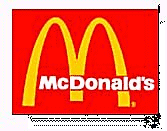COMPUTERIZED HVAC LOAD CALCULATIONS MAKES FOR FAST HVAC SYSTEM DESIGN AT MCDONALDS©
by Bill Smith, president of Elite Software
 Calculating a building's HVAC loads have come a long way since the days of fill- in-the-blank forms and tedious manual procedures. Today's powerful, and amazingly affordable, desktop computers and easy to use programs mean that HVAC designers can quickly produce highly precise designs in a fraction of the time it took just a few years ago.
Calculating a building's HVAC loads have come a long way since the days of fill- in-the-blank forms and tedious manual procedures. Today's powerful, and amazingly affordable, desktop computers and easy to use programs mean that HVAC designers can quickly produce highly precise designs in a fraction of the time it took just a few years ago.
McDonald's Corporation optimally utilizes the latest in computer and software technologies. For them, it has meant greatly improved designs of it's restaurants' HVAC systems while dramatically reducing design, installation and operating costs. Anthony Spata is a building systems engineer in corporate architecture/construction for McDonalds Corporation. He is responsible for mechanical designs for all new, and remodeled, McDonalds' restaurants throughout the U.S. There are 9,000 McDonalds in the U.S. and 14,000 worldwide. New McDonalds are currently being built at a rate of about 5 per month; for Spata, a demanding work load that requires an efficient operation.
architecture/construction for McDonalds Corporation. He is responsible for mechanical designs for all new, and remodeled, McDonalds' restaurants throughout the U.S. There are 9,000 McDonalds in the U.S. and 14,000 worldwide. New McDonalds are currently being built at a rate of about 5 per month; for Spata, a demanding work load that requires an efficient operation.
Spata points out that McDonalds' restaurants have special load considerations. "We're not just dealing with outdoor ambient conditions. We have considerable indoor load generation that often exceeds the combined effects of outdoor temperature, solar gain, etc. Our restaurants have three unique zones: a dining area, kitchen and storage area. In our dining area, we get major loads, sensible and latent, coming from our customers. And our new, more open, design of restaurants with extensive glazing means increased heat gain in summer and heat loss in winter. Our kitchens generate substantial internal heat gain from cooking equipment even though our major appliances are under exhaust hoods to vent convected heat. Radiated heat from fry vats, griddles and numerous refrigeration units contribute about a million btu's in cooking energy per day. Even the storage area with very little heat gain or loss, has to be treated separately to avoid overheating or overcooling."
He recalls the difficulties and limitations of HVAC design and how, before computerization, loads were calculated using Carrier forms and a hand calculator. "Although they were the standard of the time they left many design factors unaccounted for and forced us to make many inaccurate generalizations about our designs. In short, we were 'guesstimating' about what the building would require to maintain a comfortable condition. In addition, although the forms and hand calculations followed ASHRAE guidelines, there was no place in them for what our experience had taught us. To handle our growing volume of work, we would do two or three calculations for general geographic and climatic areas and then use two or three designs to apply to all stores.
We would then at least run three calculations for each of the three zones within the building. It would typically take two hours to calculate fully detailed loads which had to account for the building's profile, seating, orientation and finding all pertinent data from the Handbook of Fundamentals. Doing six or seven of these over a couple of days left us a little burnt out. The whole process was inexact and exceptionally time consuming as each restaurant was very different and HVAC tonnage can vary dramatically. We were always too limited by time to fine tune our designs or to perform a studied analysis for each store. Despite our best efforts, some areas were over-designed and others we were under- designed."
It was Spata's need for quick and accurate load calculations that led them to computerize and select Elite Software's popular CHVAC program for commercial load calculations. "Since we got the program four years ago, we produce much more accurate designs. And with its built-in weather data, we can make all the fine determinations we always wanted about total HVAC tonnage and just how it should be allocated."
He explains that CHVAC calculation speed allows them to employ "what-if" scenarios that have been important to precise system design. "Although we have three basic restaurant designs there are many variations. For example, a client may want to increase customer seating - we can use CHVAC to see what effect increasing seating will have on sensible and latent internal loads. We can easily evaluate just how far we can stretch a particular building's HVAC design before we have to modify the installed capacity. We can also examine alternate building materials and insulation values to determine if we get our money's worth on extra insulation or double vs. triple glazing. CHVAC let's us rapidly recalculate the loads. It gives us the ability to isolate and identify all the factors that are influencing a given design whether peak design conditions are really peak conditions."
"Now that we have more stores with a large amount of glazing building orientation to the sun has become a major concern. The program lets us quickly see the impact of changing a building's orientation. This is very important as orienting the building where it receives the least solar gain has saved us a lot of money in increased HVAC tonnage. Because the program can identify each component that makes up that total heating and cooling load it allows us to easily adjust to the requirements of a specific installation. CHVAC is critical when it comes to making these kind of economic decisions."

He points out that McDonalds will be fourty years old this year and that many restaurants are approaching 25 years of age. That means they'll be doing more and more retrofit work as old HVAC systems need replacing. He explains that many of the older HVAC designs were done manually and often were improperly designed and cost more than they should have. "In remodeling jobs it's not unusual to find a restaurant with 1.5 times the installed capacity so we don't automatically replace ton for ton. Because CHVAC produces much more precise designs we not only reduce tonnage but also operating costs. We've been able to typically save 5-10 tons in retrofits and still get the proper HVAC system. The program saves us a lot money."
Spata observes that more and more states require HVAC system designs to meet their energy compliance regulations. He reports, "Summation sheets produced by CHVAC are readily accepted as they have exactly the information the states need. They want to see the exact amount of energy expended to offset ventilation and envelope loss; and they want to see that you haven't oversized your equipment. And, he adds that a full engineer doesn't need to be involved in their load calculations. "Recently, one of our locations was required to show energy compliance and provide a full load calculation in order to get a building permit. By telephone, I was able coach one of our architect interns in another state on how to use CHVAC and do the calculations. He did the loads in the timely manner and we got the building permit. And we didn't have to have to use a P.E., in house or out of house."
Spata admits that computerization gives them the time to stay current with the latest technoligies and to find ways to incorporate them into their everyday work. "Now, we are getting ahead rather than simply keeping up with our building program. McDonald's restaurant owners are our clients. Since we've been using CHVAC we've seen a marked improvement in customer and crew comfort.
He claims that the cost of CHVAC paid for itself in his first few buildings. We operate our restaurants 316 days a year, 17 hours a day. With computerization, we minimize the cost of installed equipment and minimize its operating cost. "When you consider the cost of today's HVAC tonnage and the cost to operate it, CHVAC is a real bargain."
Spata feels that computerized load calculations sets them apart from their competition. "We think we have the best set of plans out there among competing fast food chains. We are very precise so that we minimize construction costs. And we provide all the details there so the the contractors get it right the first time. Naturally, properly designed equipment has fewer problems over time and we get fewer complaints. Getting it right the first time makes our job easier."
"Our productivity has increased dramatically. If we were doing things manually, we'd have to significantly increase staff just to handle manual calcalations. With the program, we've been able to manage an ever increasing work load with it's efficiencies and time savings."
 Mr. Smith welcomes your email about this article. - email
Mr. Smith welcomes your email about this article. - email
Copyright ©
Elite Software Development, Inc., webmaster@elitesoft.com
 Calculating a building's HVAC loads have come a long way since the days of fill- in-the-blank forms and tedious manual procedures. Today's powerful, and amazingly affordable, desktop computers and easy to use programs mean that HVAC designers can quickly produce highly precise designs in a fraction of the time it took just a few years ago.
Calculating a building's HVAC loads have come a long way since the days of fill- in-the-blank forms and tedious manual procedures. Today's powerful, and amazingly affordable, desktop computers and easy to use programs mean that HVAC designers can quickly produce highly precise designs in a fraction of the time it took just a few years ago. architecture/construction for McDonalds Corporation. He is responsible for mechanical designs for all new, and remodeled, McDonalds' restaurants throughout the U.S. There are 9,000 McDonalds in the U.S. and 14,000 worldwide. New McDonalds are currently being built at a rate of about 5 per month; for Spata, a demanding work load that requires an efficient operation.
architecture/construction for McDonalds Corporation. He is responsible for mechanical designs for all new, and remodeled, McDonalds' restaurants throughout the U.S. There are 9,000 McDonalds in the U.S. and 14,000 worldwide. New McDonalds are currently being built at a rate of about 5 per month; for Spata, a demanding work load that requires an efficient operation.
